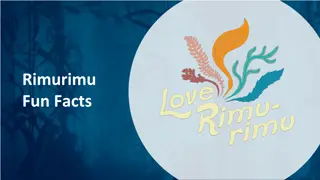Exploring the Fascinating World of Algae: A Visual Journey Through Different Phyla
Dive into the diverse and intriguing realm of algae with this visual guide. From the catchall kingdom Protista to the distinct phyla Chlorophyta, Phaeophyta, Rhodophyta, Bacillariophyta, Dinoflagellata, and more, learn about their characteristics, structures, and importance. Discover how green algae gave rise to land plants and explore the unique features of brown, red, and diatom algae. Uncover the beauty and significance of these often-overlooked organisms through stunning images and informative descriptions.
Download Presentation

Please find below an Image/Link to download the presentation.
The content on the website is provided AS IS for your information and personal use only. It may not be sold, licensed, or shared on other websites without obtaining consent from the author. Download presentation by click this link. If you encounter any issues during the download, it is possible that the publisher has removed the file from their server.
E N D
Presentation Transcript
Kingdom Protista The Catchall Kingdom
Characteristics of Algae Autotrophic Not plants why? Often contain pyrenoids
Structure of Algae Thallus or body Unicellular or multicellular Colonial: Volvoz Filamentous: Spirogyra Multicellular: Ulva Asexual and sexual reproduction
Phylums Phylum Chlorophyta Phylum Phaeophyta Phylum Rhodophyta Phylum Bacillariophyta Phylum Dinoflagellata Phylum Chrysophyta Phyla Euglenohyta
Phylum Chlorophyta Look familiar?
Continued Green algae Many different forms Gave rise to land plants why? Choroplasts that contain a and b cholorphyll Have carotenoids Cell walls of cellulose
Phylum Phaeophyta Brown algae Marine Seaweed and kelps Cooler areas of ocean Fucoxanthin pigment Store food as laminarin ALL multicellular Stemlike stipe Leaflike region called blade
Phylum Rhodophyta Red algae but colors vary Marine seaweeds Smaller than brown algae and live in deeper waters Phycobilins pigment for absorbing light Some coated with polysaccharide carageenan cosmetics, gel capsules, cheeses Agar extracted from cell walls of red algae
Phylum Bacillariophyta Diatoms Shells fit together like a box with a lid Centric and pennate Main component of phytoplankton Diatomaceous earth
Phylum Dinoflagellata Dinoflagellates Small, unicellular Most photosynthetic Some bioluminescent Red tide a problem
Phylum Chrysophyta Golden algae Most fresh water Form cysts 2 flagella Carotenoids give color Important for formation of petroleum deposits
Phylum Euglenophyta Euglenoids Plant-like and animal-like characteristics Many have cholorphyll and are photosynthetic No cell wall, motile Most live in fresh water See picture on page 533
Fungus-like protists Slime molds: Phylum acrasiomycota Cellular slime molds Amoeboid movement Water molds Phylum Oomycota Blight Phylum Chytridiomycota Chytrids Zoospores with one flagellum Maybe fungi? Phylum Myxomycota Plasmodial slime molds Mass of plasmodium
This powerpoint was kindly donated to www.worldofteaching.com http://www.worldofteaching.com is home to over a thousand powerpoints submitted by teachers. This is a completely free site and requires no registration. Please visit and I hope it will help in your teaching.























